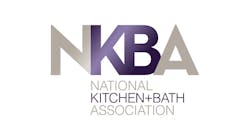Latest from Bath/Kitchen
Delta Faucet Company Adds Newport Brass to Portfolio
Sponsored

BETHLEHEM, PA – The National Kitchen & Bath Association (NKBA) has released its Kitchen & Bath Market Index (KBMI) for Q2 of 2022. The quarterly report, which assesses the overall health of the kitchen and bath industry, indicates that the sector is seeing signs of a cooldown, with industry leaders anticipating decelerated growth through the rest of the year.
Key takeaways from the report include:
- More Inventory: Manufacturers say they are receiving inventory and products faster than in previous years.
- Better Value: Kitchen and bath designers are value engineering projects for customers, choosing what is available now at affordable margins and price points. They are also reporting smaller backlogs in Q2 vs Q1.
- Future Challenges: Current guidance from the industry suggests flat or declining revenue growth in 2023, particularly in consumer-facing segments such as retail sales.
Statistics from the Q2 Kitchen & Bath Market Index show the following:
- Full year 2022 kitchen and bath sales are expected to increase by 9.4 percent, down from the 15.1 percent reported three months ago.
- Kitchen and bath sales grew 6.9 percent from Q2 2021, marking the second consecutive quarterly deceleration in year-over-year sales growth.
- 59 percent of design firms and 82 percent of building and construction firms report either cancellations or postponements of projects.
- Although Q2 construction project completions rose 6.2 percent year-over-year, supply chain issues and inflation will remain a challenge for the rest of 2022.
- Softening demand for remodeling projects has contributed to a second successive quarter of easing in capacity constraints, with 36 percent of manufacturers reporting that inventories have increased.
Kitchen and bath industry professionals say demand is steady but there are early signals the market is cooling. As reported in the KBMI, ratings above 50 indicate industry growth, while ratings below 50 indicate slowing activity. The overall KBMI for Q2 was 70.4, the lowest it has been since Q4 2020. The report findings also rated future business conditions at 61.8 on a 100-point scale. This remains well above the midpoint, but down from 78.6 in Q1, demonstrating heightened concern about the year ahead.
“While it’s encouraging to see some initial signs of easing in supply chain and inventory concerns, it’s clear that macro-economic volatility is having some initial impact on demand,” said Bill Darcy, chief executive officer, NKBA. “This is an industry that has consistently adapted to rapidly changing circumstances over the course of the past two and a half years. There is understandable concern around inflation and interest rates and the potential impact on the industry, but the industry outlook on future business conditions indicates there is still cautious confidence in the ability to navigate a path forward.”
To request the full report, contact Brittany Loeffler at [email protected].


